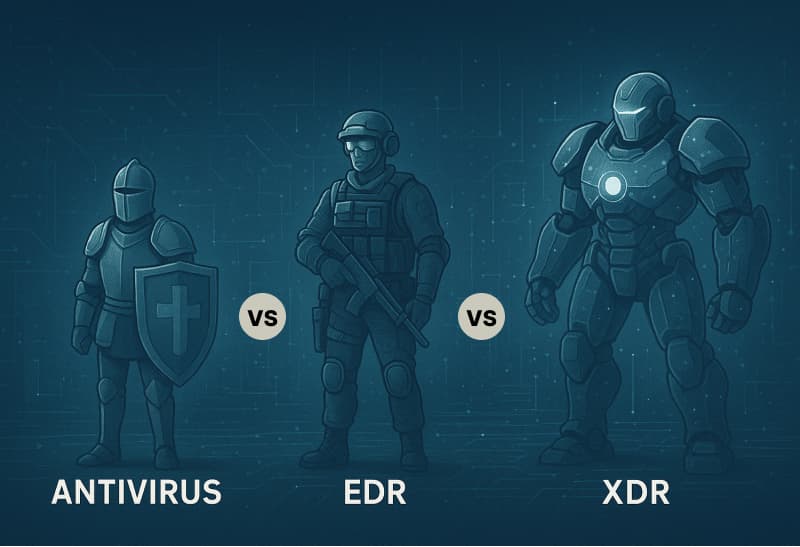It is imperative for organizations to protect endpoints for better protection from cyber threats. EDR and XDR provide this opportunity to safeguard the digital assets.

The present digital age is defined by constant interaction—people, businesses, and governments rely on countless devices and applications woven together in ways that were hard to imagine a decade ago. This interconnected fabric brings tremendous opportunities, yet at the same time it also gives openings for intrusion at every endpoint. Recent studies underline the urgency:
IBM’s 2024 report shows that the average cost of a data breach in the U.S. has jumped to $9.48 million, nearly double what it is worldwide.
As a result, protecting endpoints is now key against increasingly complex cyber threats. Nonetheless, not all protection tools will protect an endpoint to the same extent. Antivirus (AV), Endpoint Detection and Response (EDR), extended detection and response (XDR), provide varying levels of visibility, resilience, and cost. In this article, we explore what each solution delivers, where they diverge, and how to weigh the trade-offs when deciding which fits best for a modern enterprise—or for a smaller business determined to safeguard its digital assets.
Antivirus tools historically depended primarily on signature-based detection: comparing files, processes, or software behavior against previously known threats. If it matched, AV would block, quarantine, or remove the threat. This works reasonably well for known malware, viruses, worms, etc., but the threat landscape has shifted:
Thus, even though antivirus is still considered basic hygiene, it does not offer tremendous behavioral analytics or response orchestration or cross-environment visibility.
“Traditional antivirus is still widely used. About 51% of respondents reported having antivirus or antimalware solutions, notes Expert Insights, though most now see it as only a baseline layer.”
Source: Expert Insights – EDR Market Overview
EDR takes AV further. In other words, it is intended to provide insights for monitoring activities on endpoints (laptops, desktops, servers, mobile devices), collecting telemetry information about behavior (process, file changes, network connections, system events, etc.), and apply either analytics or machine learning to identify suspicious behavior.
Key features include:
However, EDR is primarily endpoint-centric; it may not see how an attack travels via identity systems, cloud workloads, email, or across network borders unless additional systems are integrated.
“Adoption is growing fast. Around 48% of organizations have deployed EDR solutions, according to Expert Insights, reflecting its role as a critical upgrade from AV.”
Source: Expert Insights – EDR Market Overview
XDR is an evolution (or extension) of EDR. Instead of looking primarily at the end-user device, XDR attempts to expand and offer larger and more integrated visibility of the total security posture. While an EDR solution focuses upon the end-user device, XDR provides combined visibility from multiple telemetry sources (end-user devices, network traffic, identity systems, cloud logs, email gateways, etc.) with automated correlation of alerts and coordinated response across tiers.
Key advantages include:
“Credential-based threats are surging. The Verizon DBIR 2025 reports that—22% of breaches start with stolen logins, and 88% of basic web app attacks involve them.”
Source: N-Able – EDR vs XDR (citing Verizon DBIR 2025)
Here’s a comparative look at how they differ along important dimensions:
|
Dimension |
Antivirus (AV) |
EDR |
XDR |
|
Scope of detection |
Known malware, signatures, some heuristic rules |
Endpoint behavior, anomalies, threats on devices |
Endpoint + identity + network + cloud + email + etc. |
|
Response capabilities |
Quarantine, remove known threats |
Endpoint isolation, process kill, forensic data |
Coordinated across layers; automated high-confidence response |
|
Threat hunting / sophistication |
Minimal; mostly reactive |
Moderate; focused on endpoints |
High; able to detect multi-vector, stealthy attacks |
|
Visibility & context |
Low; limited to device and signature matches |
Better; detailed endpoint telemetry |
Broad; unified view, cross-environment correlations |
|
Complexity & cost |
Low; easy to deploy, manage, lower cost |
Medium; requires skilled staff, configuration |
High; integration, data volumes, more moving parts |
|
Suitability |
Small businesses, basic protection, low risk tolerances |
Organizations with moderate risk, interested in proactive defense |
Enterprises, regulated industries, high risk, complex environments |
No solution is perfect. Therefore, here are trade-offs to evaluate:
Here are some steps or criteria to help you decide:
Antivirus remains a must-have for any endpoint security strategy—you can’t skip it—but by itself, it’s not enough to mitigate today’s advanced cyber threats. EDR (Endpoint Detection and Response) is the next step for organizations that need better visibility, faster response, and proactive threat hunting, covering gaps that traditional antivirus leaves behind. XDR (Extended Detection and Response) goes further, giving a unified view across endpoints, networks, cloud, and identity systems—ideal for complex, high-risk, or compliance-driven environments. It comes with higher cost and complexity, so a layered approach usually works best: strong antivirus, EDR for critical systems, and XDR as your cybersecurity needs, threat landscape, or regulatory requirements evolve.
1. What are the differences between EDR and XDR?
EDR does the monitoring, detection, and response at the endpoint level. Whereas, XDR goes even beyond this. It incorporates data from endpoints, cloud, identity, email, and networks to provide a holistic defense.
2. Do I still need an antivirus with EDR or XDR?
Yes. Antivirus lets us resolve known malware quickly. While EDR and XDR provide advanced threat detection and response. As a result, almost all organizations use them together.
3. Is EDR or XDR more economical?
Typically EDR is less expensive. The cost of XDR is more because it layers together multiple solutions, but it can also result in less tool sprawl and better long term ROI.
4. How do I know which solution is best?
Think about size, risk, or resource. Smaller organizations might be focused on a mix of AV and EDR, but larger enterprises looking into cloud or hybrid systems would benefit from an XDR solution.
5. Will XDR replace my SOC team?
No. XDR can help automate and streamline alerts but you will still need capable people to investigate, tune, or strategize.